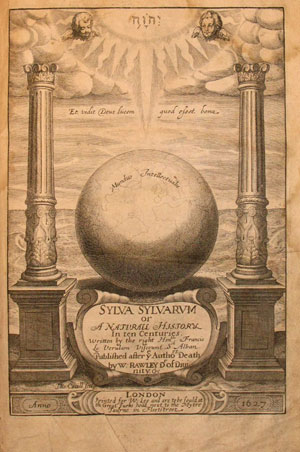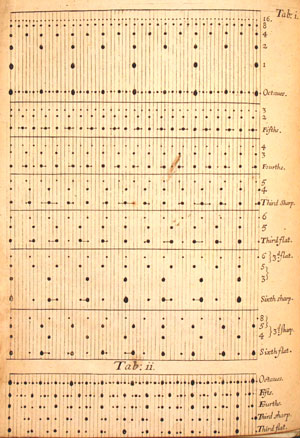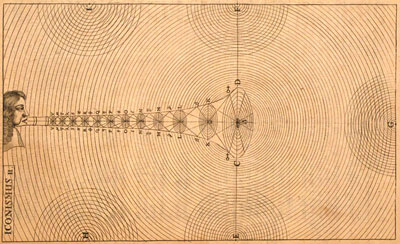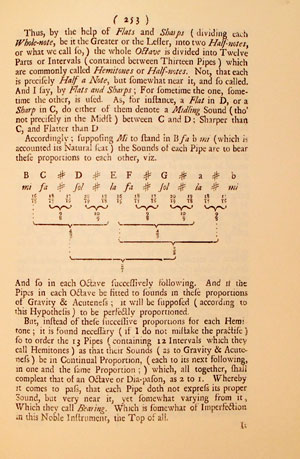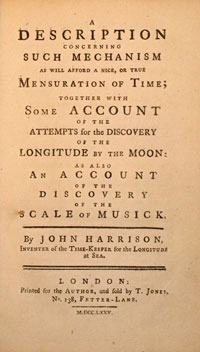Francis Bacon (1561–1626) and the Royal Society
Francis Bacon, Sylva sylvarum: or a Naturall Historie. In Ten Centuries (London, 1627)
Whilst ancient Greek music theory would continue to interest scientists and music theorists into the 19th century, the 17th century saw a related development in acoustics, or, the science of sound. In his Sylva sylvarum Bacon rejected the Pythagorean tradition with its mystical belief in numbers as the cause of consonance. Instead he proposed a science of acoustics involving the study of the properties of sound in order to discover the nature of consonance.
Royal Society
Established in 1660 the Royal Society sought to realise Bacon's vision of experimental science as a collective activity undertaken for the good of the state. Correspondence, reports of meetings, and published writings in the society's Philosophical Transactions testify to the position of Acoustics as a key element in the early Royal Society's experimental philosophy.
Francis North, Baron Guilford, A Philosophical Essay of Musick Directed to a Friend (London, 1677)
A new acoustics-based explanation for consonance was provided in the Coincidence Theory. In place of the Pythagorean belief in the mystical properties of numbers, this mechanistic explanation associated musical sound with a series of pulses or blows. Dissonance occurred when pulses did not form a ratio of whole numbers and thus did not blend.
A version of the Coincidence Theory is described in A Philosophical Essay of Musick (1677), by Francis North (1637–1685), a high ranking government minister with links to the Royal Society. This work sought to 'explain the nature of musick' and thereby provide a mechanistic basis for musical harmony. North described this illustration of the Coincidence Theory as a 'Scheme whereby the Simmetry of the Pulses ranged in Musical proportion appears'.
Samuel Morland, Tuba Stentoro-Phonica: an Instrument of Excellent Use, As Well at Sea, as at Land; Invented and Variously Experimented in the Year 1670. And Humbly Presented to the King’s Most Excellent Majesty Charles II. In the Year 1671 (London, 1672)
In this book Samuel Morland (1625–95) describes a new invention: Tuba stentoro-phonica: an instrument of excellent use, as well at sea, as at land. The result of much acoustical experimentation, Morland claimed that his instrument enabled spoken communication at a mile's distance.
Here Morland illustrates how the voice is transmitted via his trumpet-like instrument.
Philosophical Transactions, 20 (1698) pp. 249–56
Royal Society theorists remained fascinated by ancient Greek theory. The prominent mathematician John Wallis had been the first to translate from Greek into Latin the ancient Greek theorist Ptolemy's Harmonics. Further music related writings by Wallis can be found in Philosophical Transactions.
A matter of particular importance for Wallis and many others was the mathematical basis for tuning. This arose, in part, from the fact that a fixed pitch keyboard instrument tuned to whole number ratios would be in tune and playable only in a limited number of keys (owing to the fact that three mathematically correct major 3rds fall short of an octave by ca. 1/5th of a whole tone). By the late 17th century changes had taken place in musical composition whereby, increasingly, a diverse range of keys was called for by composers. Anxious to demonstrate music's continued foundation on mathematical truth, many Royal Society theorists wrote about tuning. One of many examples is the publication in Philosophical Transactions of 'A Letter of Dr John Wallis to Samuel Pepys Esquire, Relating to some Supposed Imperfections in an Organ'.
Here Wallis shows how the scale might be divided mathematically to achieve intervals made up of whole number ratios.
Philosophical Transactions, 24 (1704–5) pp. 2072–7
Another associate of Wallis, Thomas Salmon also published several musically related items in Philosophical Transactions. In his 'Theory of Musick Reduced to Arithmetical and Geometrical Proportions' Thomas Salmon sought to give a 'farther account of the Theory of Musick' so that it might be 'fixed upon the sure foundations of mathematical certainty'. Believing that the more accurate the proportions, the stronger would be music's influence on the soul, he argued that musical pleasure arose 'from the exactness of sonorous numbers'.
These six lines represent the six strings of the Viol 'wherin the Proportions of Musick are described Geometrically'.
John Harrison, A Description concerning Such Mechanism As Will Afford a Nice, or True Mensuration of Time: Together with Some Account of the Attempts for the Discovery of the Longitude by the Moon: As Also an Account of the Discovery of the Scale of Musick (London, 1775)
That tuning and music continued to be an area of interest to mathematicians is evident in this work written by John Harrison (1693–1776), the famous clockmaker who helped solve the problem of longitude. Appended to his Description concerning Such Mechanism As Will Afford a Nice, or True Mensuration of Time (London, 1775) is his Account of the Discovery of the Scale of Musick.
Here he claimed to have superseded the ancients through his discovery of the number Pi as means of organising the musical scale. Harrison explained that 'As the Diameter and Radius of a Circle bear respectively to the Circumference; so do[es] the sharp 3rd...bear respectively to the octave... and from whence all the others notes are generated, have you as many keys, viz. by Flats and Sharps, as you please...I say, as thence in the whole... are generated to a mathematical degree of sweetness, if I may term it, as well as to a surprising mathematical degree in proportion...'
Despite Harrison's claims, as a method of tuning this theory proved impractical. It is, however, testament to the 18th-century desire to establish the 12 note chromatic scale together with the modern tonal system upon a universally significant mathematical foundation.

